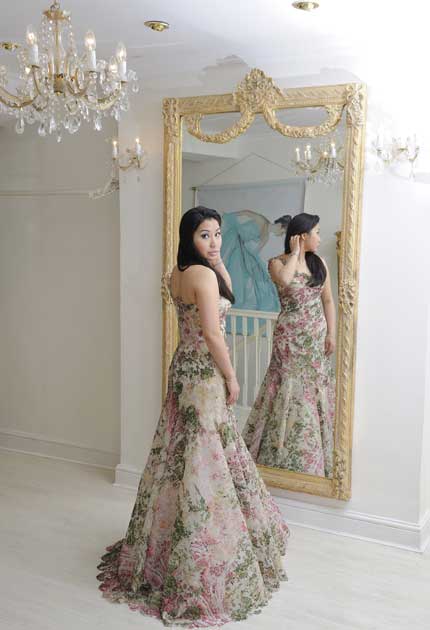Classical music: It's a concert, not a catwalk

Your support helps us to tell the story
From reproductive rights to climate change to Big Tech, The Independent is on the ground when the story is developing. Whether it's investigating the financials of Elon Musk's pro-Trump PAC or producing our latest documentary, 'The A Word', which shines a light on the American women fighting for reproductive rights, we know how important it is to parse out the facts from the messaging.
At such a critical moment in US history, we need reporters on the ground. Your donation allows us to keep sending journalists to speak to both sides of the story.
The Independent is trusted by Americans across the entire political spectrum. And unlike many other quality news outlets, we choose not to lock Americans out of our reporting and analysis with paywalls. We believe quality journalism should be available to everyone, paid for by those who can afford it.
Your support makes all the difference.Sarah Chang is resplendent in front of the mirror at the Kruszynska boutique in Knightsbridge. She's popped in for a concert gown fitting and has donned a fairytale creation of delicate pink and green lace over ivory silk. It's perfect for Mozart and it looks stunning.
But maybe it is also symptomatic of the way that classical music's female stars have collided with popular culture. A woman musician can play wonderfully and she can also look good – but what exactly is the top priority these days? The case of Susan Boyle has brought this issue into the headlines on an even wider scale.
Half a century ago, most female musicians did not care about their appearance: what mattered was how they sounded. Indeed, a "high priestess" attitude seemed to be positively encouraged; anything visual was downplayed so that the music could sing out unimpeded.
In the 1940s, the pianist Dame Myra Hess always wore a plain black dress for her concerts. The late Rosalyn Tureck, famed for her Bach, was not amused when a press photographer captured an image of her, in her twenties, focusing on her legs. Conversely, the Australian pianist Eileen Joyce (who plays Rachmaninov on the soundtrack of Brief Encounter) enjoyed coordinating her dresses with the music she was playing, often changing between pieces. Then, it caused amusement. Now, though, it's de rigeur.
Chang, 28, adores high fashion and heels, but insists that her concert clothes shouldn't be a distraction. "They must be repertoire-appropriate," she tells me. "When I need a dress for the Brahms Concerto it must be substantial and robust, but if I'm doing a big Carmen concert the dress can be red and hot and fun."
But has the pressure on young women musicians to look like supermodels gone too far? After all, these women have spent most of their lives practising their instruments for long, lonely hours, devoting themselves tirelessly to the interpretation of great music, making huge personal sacrifices and struggling for recognition. Then they're judged on how they look. This is patently daft.
Of course, male musicians have worked equally as hard, but men of comparable talent can simply don a tux or tails, brush a few strands of hair over the bald patch and stride on to a stage without worrying that they don't look as if they've just stepped off a catwalk. The music industry loves men who look good, but it's not a prerequisite. For 21st-century women soloists, a gift for music is just not enough, it seems.
Female singers can get away with being overweight – a spare tyre supports the voice. But when did you last see in the world's top concert halls a woman violin soloist plumper than a size 10, or a bat-winged female pianist over the age of 60? Yet some of today's greatest musicians are seriously unphotogenic men. Grigory Sokolov, among the finest pianists on earth, is like a Siberian bear. Nigel Kennedy is no oil painting. Would women with the equivalent in talent and looks have had the same opportunities to shine? The thought is a sobering one.
Some female musicians might have poorer careers if it were not for their physical beauty. This sounds frivolous, but there's a darker aspect to it. I've attended music festivals (usually run by men) at which the women performers have all been not only gifted but also young, willowy and grateful. I've met female would-be soloists whose hopes of concert engagements following auditions have been dashed when they refused to do certain things beyond playing the music. And I've heard interpretations of great concertos by a few well-established women who look fabulous and whose images have been plastered over every music magazine, yet whose questionable musicianship has left me infuriated.
Equally iniquitous is that some of the stuffier critics seem to automatically take against glamorously dressed female soloists. In some cases these musicians really are fabulous, yet find themselves presumed frivolous – again, judged for their appearance, rather than for their expertise.
Sarah Chang is fortunate: she has it all. But spare a thought for the undiscovered Susan Boyles of classical music who may never be noticed in a world in which the core values have become dangerously skewed.
Sarah Chang performs with the Philharmonia Orchestra on tour to 7 May ( www. philharmonia. co.uk )
Join our commenting forum
Join thought-provoking conversations, follow other Independent readers and see their replies
Comments